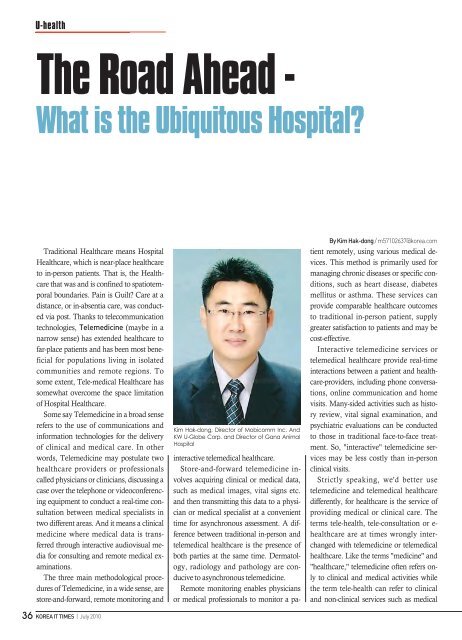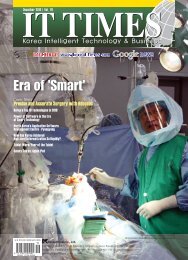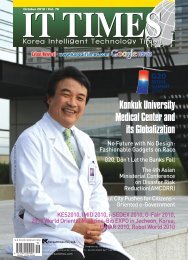2010-07 - Korea IT Times
2010-07 - Korea IT Times
2010-07 - Korea IT Times
You also want an ePaper? Increase the reach of your titles
YUMPU automatically turns print PDFs into web optimized ePapers that Google loves.
U-health<br />
The Road Ahead -<br />
What is the Ubiquitous Hospital?<br />
Traditional Healthcare means Hospital<br />
Healthcare, which is near-place healthcare<br />
to in-person patients. That is, the Healthcare<br />
that was and is confined to spatiotemporal<br />
boundaries. Pain is Guilt? Care at a<br />
distance, or in-absentia care, was conducted<br />
via post. Thanks to telecommunication<br />
technologies, Telemedicine (maybe in a<br />
narrow sense) has extended healthcare to<br />
far-place patients and has been most beneficial<br />
for populations living in isolated<br />
communities and remote regions. To<br />
some extent, Tele-medical Healthcare has<br />
somewhat overcome the space limitation<br />
of Hospital Healthcare.<br />
Some say Telemedicine in a broad sense<br />
refers to the use of communications and<br />
information technologies for the delivery<br />
of clinical and medical care. In other<br />
words, Telemedicine may postulate two<br />
healthcare providers or professionals<br />
called physicians or clinicians, discussing a<br />
case over the telephone or videoconferencing<br />
equipment to conduct a real-time consultation<br />
between medical specialists in<br />
two different areas. And it means a clinical<br />
medicine where medical data is transferred<br />
through interactive audiovisual media<br />
for consulting and remote medical examinations.<br />
The three main methodological procedures<br />
of Telemedicine, in a wide sense, are<br />
store-and-forward, remote monitoring and<br />
36 KOREA <strong>IT</strong> TIMES | July <strong>2010</strong><br />
Kim Hak-dong, Director of Mobicomm Inc. And<br />
KW U-Globe Corp. and Director of Gana Animal<br />
Hospital<br />
interactive telemedical healthcare.<br />
Store-and-forward telemedicine involves<br />
acquiring clinical or medical data,<br />
such as medical images, vital signs etc.<br />
and then transmitting this data to a physician<br />
or medical specialist at a convenient<br />
time for asynchronous assessment. A difference<br />
between traditional in-person and<br />
telemedical healthcare is the presence of<br />
both parties at the same time. Dermatology,<br />
radiology and pathology are conducive<br />
to asynchronous telemedicine.<br />
Remote monitoring enables physicians<br />
or medical professionals to monitor a pa-<br />
By Kim Hak-dong/ m57102637@korea.com<br />
tient remotely, using various medical devices.<br />
This method is primarily used for<br />
managing chronic diseases or specific conditions,<br />
such as heart disease, diabetes<br />
mellitus or asthma. These services can<br />
provide comparable healthcare outcomes<br />
to traditional in-person patient, supply<br />
greater satisfaction to patients and may be<br />
cost-effective.<br />
Interactive telemedicine services or<br />
telemedical healthcare provide real-time<br />
interactions between a patient and healthcare-providers,<br />
including phone conversations,<br />
online communication and home<br />
visits. Many-sided activities such as history<br />
review, vital signal examination, and<br />
psychiatric evaluations can be conducted<br />
to those in traditional face-to-face treatment.<br />
So, "interactive" telemedicine services<br />
may be less costly than in-person<br />
clinical visits.<br />
Strictly speaking, we'd better use<br />
telemedicine and telemedical healthcare<br />
differently, for healthcare is the service of<br />
providing medical or clinical care. The<br />
terms tele-health, tele-consultation or e-<br />
healthcare are at times wrongly interchanged<br />
with telemedicine or telemedical<br />
healthcare. Like the terms "medicine" and<br />
"healthcare," telemedicine often refers only<br />
to clinical and medical activities while<br />
the term tele-health can refer to clinical<br />
and non-clinical services such as medical

















